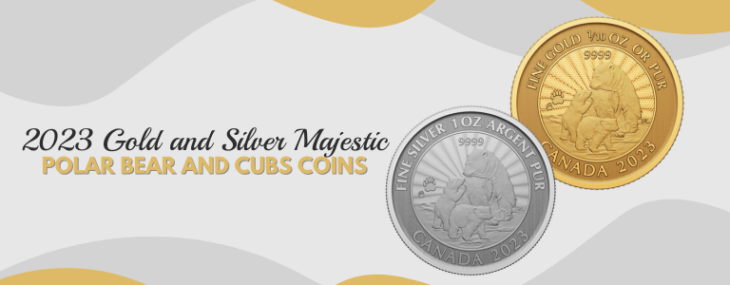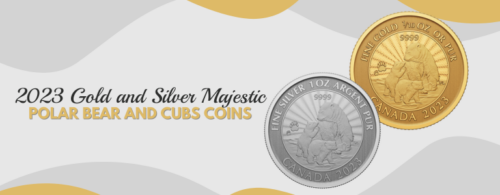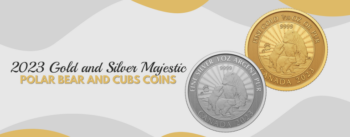Last updated on July 2nd, 2025 at 11:41 am
Last Updated on July 2, 2025 Posted by Colonial Acres Coins
The 2023 Royal Canadian Mint polar bear coin has been released and appeals to investors and collectors alike. Though the largest carnivore to live primarily on land, polar bears are born small and helpless. Fortunately, polar bear females are excellent mothers, going to great lengths to protect their cubs and teach them the skills they need to survive. The Majestic Polar Bear coin depicts the special relationship between the mother polar bear and her cubs.
Polar Bear Pregnancy
Polar bears have an eight-month gestation period. During the first four months, the fertilized egg forms a blastocyst, a hollow ball of cells. The blastocyst does not implant in the uterine wall until about halfway through the gestation period. As a result, the cubs are born at the time of year most favourable to their survival.
Female polar bears build up stores of fat so they can spend their entire pregnancy in a safe and cozy den. They do not go hunting again until after the cubs are born and are old enough and strong enough to withstand conditions outside the den.
Polar Bear Cubs’ Birth
Polar bears usually give birth to either one or two cubs at a time. Rarely, a female polar bear may give birth to three cubs at once. Newborn polar bear cubs appear hairless, but actually, they have very fine fur. Their eyes are closed at birth. Newborn polar bears are 30 centimetres long and weigh less than a kilogram. They are helpless and entirely dependent on their mother.
Nevertheless, the cubs grow rapidly from feeding on their mother’s milk, which is about 30% fat at the time of the cubs’ birth. By the time they are three months old, the cubs have grown 20 times their original body weight. The mother polar bear could continue to nurse her cubs for one to two years.
Polar Bear Family Life
Polar bear cubs stay with their mother for two years. During this time, the mother teaches the cubs everything they need to know to survive on their own. The polar bear mother has to strike a balance between the cubs’ safety and the family’s survival. For example, the best hunting spots may expose the cubs to dangers such as frigid waters in which they could drown or male polar bears, which may attack cubs.
Polar bear cubs learn by watching their mother as she hunts seals and navigates sea ice. They are very good at mimicking their mom’s movements. As the cubs grow older, some remain attentive students, while others start to become restless.
A Design Overview of the Polar Bear Cubs Coin
The reverse image of the Majestic Polar Bear coin is based on Canadian artist Pierre Leduc’s design. It depicts a mother polar bear with two cubs. One cub appears to be observing the horizon. The other cub has its front feet up against its mother, trying to get her attention, while she turns her head to see what the cub wants. In the background, a sunburst of radial lines creates the impression of energy and movement.
To the viewer’s left of the image, the coin bears a privy mark of the mother polar bear’s paw print with the significantly smaller cub’s paw print right next to it. This represents the closeness of the polar bear family.
The Royal Canadian Mint polar bear coin is available as gold or silver Premium Bullion. Each is sold in its own special packaging that includes the assay certificate and provides an unobstructed view of all the coin’s features, both front and back. Purchase this coin from Colonial Acres to add to your collection or to give as a gift to someone with whom you are close.




